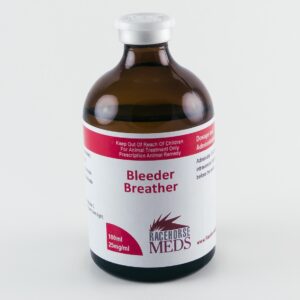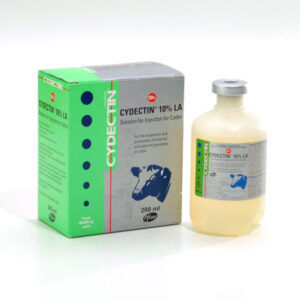Resflor 100ml Treatment of respiratory infections caused by Mannheimia haemolytica, Pasteurella multocida, Resflor 100ml Mycoplasma bovis and Histophilus somni associated with pyrexia. Resflor contains Florfenicol and Flunixin to provide an antibiotic and anti inflammatory and anti pyrexic in one dose.
Resflor 300/16.5 mg/ml Solution for Injection for Cattle.
Qualitative and quantitative composition
Active substance: | per ml | |
Florfenicol | 300 mg | |
Flunixin (as flunixin meglumine) | 16.5 mg | |
Excipients: | ||
Propylene glycol (Antimicrobial Preservative) | ||
E 1520 | 150 mg |
For a full list of excipients, see section “Pharmaceutical Particulars”.
Pharmaceutical form
Solution for injection. Clear, light yellow to straw coloured liquid.
Clinical particulars
Target species
Cattle
Indications for use
Curative treatment of respiratory infections caused by Mannheimia haemolytica, Pasteurella multocida and Histophilus somni associated with pyrexia.
Contra-indications
Do not use in adult bulls intended for breeding purposes. Do not use in animals suffering from hepatic and renal diseases. Do not use if there is a risk of gastrointestinal bleeding or in cases where there is evidence of altered haemostasis. Do not use in animals suffering from cardiac diseases. Do not use in the case of known hypersensitivity to active substances or to any of the excipients.
Special warnings for each target species
None.
Special precautions for use
The product should be used in conjunction with susceptibility testing and take into account official and local antimicrobial policies. Avoid use in dehydrated, hypovolaemic or hypotensive animals as there is a potential risk of increased renal toxicity. Concurrent administration of potentially nephrotoxic drugs should be avoided.
Repeated daily dosing has been associated with abomasal erosions in the pre-ruminant calf. The product should be used with caution in this age group. The safety of the product has not been tested in calves of 3 weeks of age or less.
Operator warnings
Care should be taken to avoid accidental self-injection. Wash hands after use. Do not use the product in known cases of sensitivity to propylene glycol and polyethylene glycols.
Adverse reactions
Subcutaneous administration of the product may result in injection site swellings that become palpable 2-3 days after injection. The duration of the injection site swellings ranged from 15-36 days post-injection. Grossly, this is associated with minimal to mild irritation of the subcutis. Extension into the underlying muscle was noted in only a few instances. By 56 days post-dosing, no gross lesions were observed that would require any trim-out at slaughter.
Use during pregnancy, lactation or lay
The effect of florfenicol on bovine reproductive performance, pregnancy and lactation has not been assessed. Use only accordingly to the benefit/risk assessment by the responsible veterinarian.
Resflor 100ml Interactions
Concurrent use of other active substances that have a high degree of protein binding may compete with flunixin for binding and thus lead to toxic effects. Pre-treatment with other anti-inflammatory substances may result in additional or increased adverse effects and accordingly a treatment-free period with such drugs should be observed for at least 24 hours before the commencement of treatment. The treatment-free period, however, should take into account the pharmacokinetic properties of the products used previously. The product must not be administered in conjunction with other NSAIDs or glucocorticosteroids. Gastrointestinal tract ulceration may be exacerbated by corticosteroids in animals given NSAIDs.
Resflor 100ml Amounts to be administered and administration route
40 mg/kg florfenicol and 2.2 mg/kg flunixin (2 ml/15 kg body weight) to be administered by a single subcutaneous injection. To ensure correct dosage and avoid under dosing, bodyweight should be determined as accurately as possible. The dose volume given at any one injection site should not exceed 10 ml. It is recommended to treat animals in the early stages of the disease and to evaluate the response to treatment 48 hours after injection. The anti-inflammatory component of Resflor, flunixin, may mask a poor bacteriological response to florfenicol in the first 24 hours after injection. If clinical signs of respiratory disease persist or increase, or if relapse occurs, treatment should be changed, using another antibiotic, and continued until clinical signs have resolved. The injection should only be given in the neck. Swab septum before removing each dose. Use a dry sterile needle and syringe.
Resflor 100ml Overdose
Overdose studies in the target species for 3 times the duration of treatment showed decreased food consumption in the groups given 3 and 5 times the recommended dose. Decreased body weights were observed in the 5 times overdose group (secondary to decreased food consumption). Decreased water consumption was observed in the 5 times overdose group. Tissue irritation increases with injection volume.
Treatment at 3 times the recommended treatment duration was associated with dose related erosive and ulcerative abomasum lesions
Resflor 100ml Withdrawal periods
Meat and offal:46 days.
Milk: Not authorized for use in lactating animals producing milk for human consumption. Do not use during lactation or drying off periods. Do not use in pregnant animals which are intended to produce milk for human consumption within 2 months of expected parturition.
Pharmacological particulars
Pharmacotherapeutic Group: antibacterials for systemic use, amphenicols, combinations.
ATCvet Code: QJ01BA99
Resflor 100ml Pharmacodynamic properties
Florfenicol is a synthetic broad spectrum antibiotic effective against most Gram-positive and Gram-negative bacteria isolated from domestic animals. Florfenicol acts by inhibiting bacterial protein synthesis at the ribosomal level and is bacteriostatic. Laboratory tests have shown that florfenicol is active against the most commonly isolated bacterial pathogens involved in bovine respiratory disease which include M. haemolytica, P. multocida and H. somni. Florfenicol is considered to be a bacteriostatic agent, but in vitro studies of florfenicol demonstrate bactericidal activity against M. haemolytica, P. multocida and H. somni. Florfenicol bactericidal activity was characterised as essentially time dependant against the three target pathogens with the possible exception of H. somni where a concentration dependency was observed. During the florfenicol susceptibility monitoring program (2000-2003) a total of 487 M. haemolytica, 522 P. multocida and 25 H. somni isolates were collected. MIC values ranged between <0.12 and 2 µg/ml for M. haemolytica (MIC90 = 1 µg/ml), between <0.12 and 2 µg/ml for P. multocida (MIC90 = 0.50 µg/ml) and between 0.12 and 0.5 µg/ml for H. somni. Breakpoints have been established by the CLSI (Clinical and Laboratory Standard Institute) for bovine respiratory pathogens as follows:
Table for Resflor 300/16.5 mg/ml | |||||||
Pathogen | Florfenicol Disk Concentration (µg) | Diameter (mm) | MIC (µg/ml) | ||||
S | I | R | S | I | R | ||
M. haemolytica P. multocida H. somni | 30 | =19 | 15-18 | =14 | =2 | 4 | =8 |
The only mechanisms of chloramphenicol resistance that are known to have significant clinical relevance are CAT-mediated inactivation and efflux-pump resistance. Of these, only some of the efflux mediated resistance would also confer resistance to florfenicol and thus have the potential to be affected by florfenicol use in animals. Resistance to florfenicol in the target pathogens has only been reported on rare occasions and was associated with efflux pump and the presence of the floR gene. Flunixin meglumine is a non-steroidal anti-inflammatory drug with analgesic and antipyretic activity. Flunixin meglumine acts as a reversible non-selective inhibitor of cyclo-oxygenase (both COX 1 and COX 2 forms), an important enzyme in the arachidonic acid cascade pathway which is responsible for converting arachidonic acid to cyclic endoperoxides. Consequently, synthesis of eicosanoids, important mediators of the inflammatory process involved in central pyresis, pain perception and tissue inflammation, is inhibited. Through its effects on the arachidonic acid cascade, flunixin also inhibits the production of thromboxane, a potent platelet pro-aggregator and vasoconstrictor which is released during blood clotting. Flunixin exerts its antipyretic effect by inhibiting prostaglandin E2 synthesis in the hypothalamus. Although flunixin has no direct effect on endotoxins after they have been produced, it reduces prostaglandin production and hence reduces the many effects of the prostaglandin cascade. Prostaglandins are part of the complex processes involved in the development of endotoxic shock.
Pharmacokinetic properties
The administration of the product by the subcutaneous route at the recommended dosage of 40 mg/kg florfenicol maintained efficacious plasma levels in cattle (i.e. above the MIC90 of the least sensitive respiratory pathogen, M. haemolytica) for longer than 39 hours. Maximum plasma concentration (Cmax) of approximately 4.3 µg/ml occurred approximately 5.5 hours (Tmax) after dosing. After administration of the product by the subcutaneous route at the recommended dosage of 2.2 mg/kg flunixin peak plasma concentrations of 2.9 µg/ml were achieved after 1.3 hours. The volume of distribution was approximately 2 litres per kg. The binding of florfenicol on proteins is approximately 20% and for flunixin > 99%. The degree of elimination of florfenicol residues in urine is approximately 68% and in faeces approximately 8%. The degree of elimination of flunixin residues in urine is approximately 34% and for faeces approximately 57%.
Pharmaceutical particulars
Excipients
Propylene glycol (E1520), N-methyl-2-pyrrolidone, Anhydrous citric acid and (Macrogol 300).
Major incompatibilities
Do not mix the product with other medicinal products.
Shelf life
Shelf life of the veterinary medicinal product as packaged for sale: 2 years.
Shelf life after first opening the immediate packaging: 28 days.
Special precautions for storage
Do not store above 25°C. Do not freeze. Protect from frost.
Immediate packaging
Glass vials of 100 ml and 250 ml with Bromobutyl stopper and Aluminium cap. Not all pack sizes may be marketed.





Reviews
There are no reviews yet.